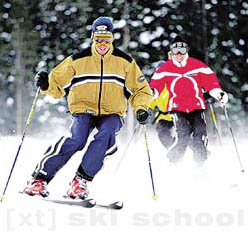|
Skiing the Moguls for Competition
Mogul skiing is unique because you will use a specialized technique. Because of the uneven terrain, balance is the first skill in this technique. Your body has to adapt to the irregular terrain in order to maintain balance. You must have a strong sense of balance in all terrain to ski moguls well. The second consideration in technique revolves around edging, pressure and rotary control movements.
The stance used in skiing the moguls is what makes mogul skiing so hard to master. It stance is very narrow -- almost locked together in appearance. The reality of this style is the skis are close together, but they still work independently. The hips are centered over the boots, and they are perpendicular to the falline along with the shoulders. The arms should be out in front parallel with the ground.
Knee action
The lower body should be able to adapt to the terrain changes of the bumps while maintaining a strong balanced position. The thighs must be kept tightly together along with the knees in order to follow the same path between the moguls and increase the ability to absorb the impact of the moguls. The knees should be held with one slightly ahead of the other. The forward knee is attached to the outside ski, and as the lead ski changes, the lead knee changes. This allows you independent foot action. As the slight turn is made in the mogul course, the outside knee can be angulated into the pocket behind the fore or inside knee. The inside ski (because it is so close to the outside ski) compliments the turning ability and arcs along with the dominant outside ski. The lead knee position allows for increased angulation. Without this position, the hip would have to be rotated to make up for the loss of angulation. This use of the hip will effectively take balance away. The mogul technique is in opposition from alpine racing. The hip width stance of ski racing will make balance impossible on uneven terrain of the moguls.
Flex the knees to absorb the bumps
In order to maintain flow during a mogul run, the upper body movements should be minimized both vertically and laterally. The lower body should be moving in a generally longer path as it goes up and around the bumps. The skis should be kept on the snow as much as possible, and the tips should be driven down onto the snow immediately after the absorption of the bump. This flexion should be done while the center of mass is over the boots. This is important because an aft position on the skis will result and balance will be lost. If the aft position is not corrected, the skis will lose contact with the snow, and ultimately, the body will become unbalanced. The skis must be angulated in order to control speed and direction. The angulation comes from the knees and somewhat from the ankles. The hip is not used for angulation and turning as it tends to over emphasize the movement and oversteer the skis.
Pressure
The pressure is outside ski dominant, but during the transition, the pressure is evenly distributed over both skis. The mogul turn is generally completed in the top half of the turn arc, after which, the pressure is evened over both skis. The even distribution makes for a speedy and balanced early pressure and edge change, and the line should be high and across the shoulder of the bumps. The pressure on the skis is forward, which makes for a quick initiation, and the pressure makes it easy to drive the tip onto the snow.
Pole plant
The pole plant is the crowning jewel of mogul skiing as it strengthens balance and maintains a perpendicular stance. The pole is planted with a minimal of hand movement and quickly released. The hands should drive forward immediately after the plant in order to maintain a forward position on the skis. The pole plant should be targeted at the a point on the crest of the bump.
Alpine Skiing School section in english version of WWW.SKI.BG is based on
"A Guide To Becoming An Expert: From First Time To A Lifetime"
by John Mukavitz Copyright © 1998

|


